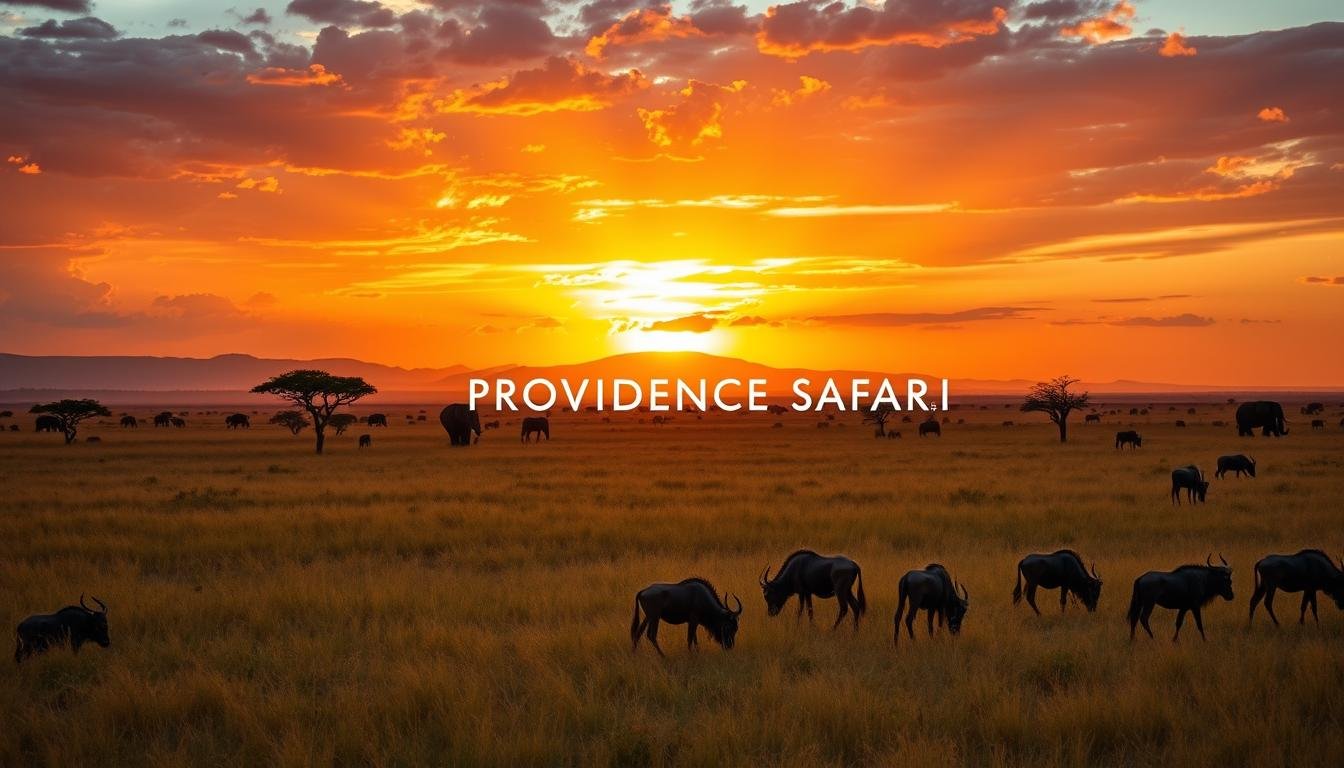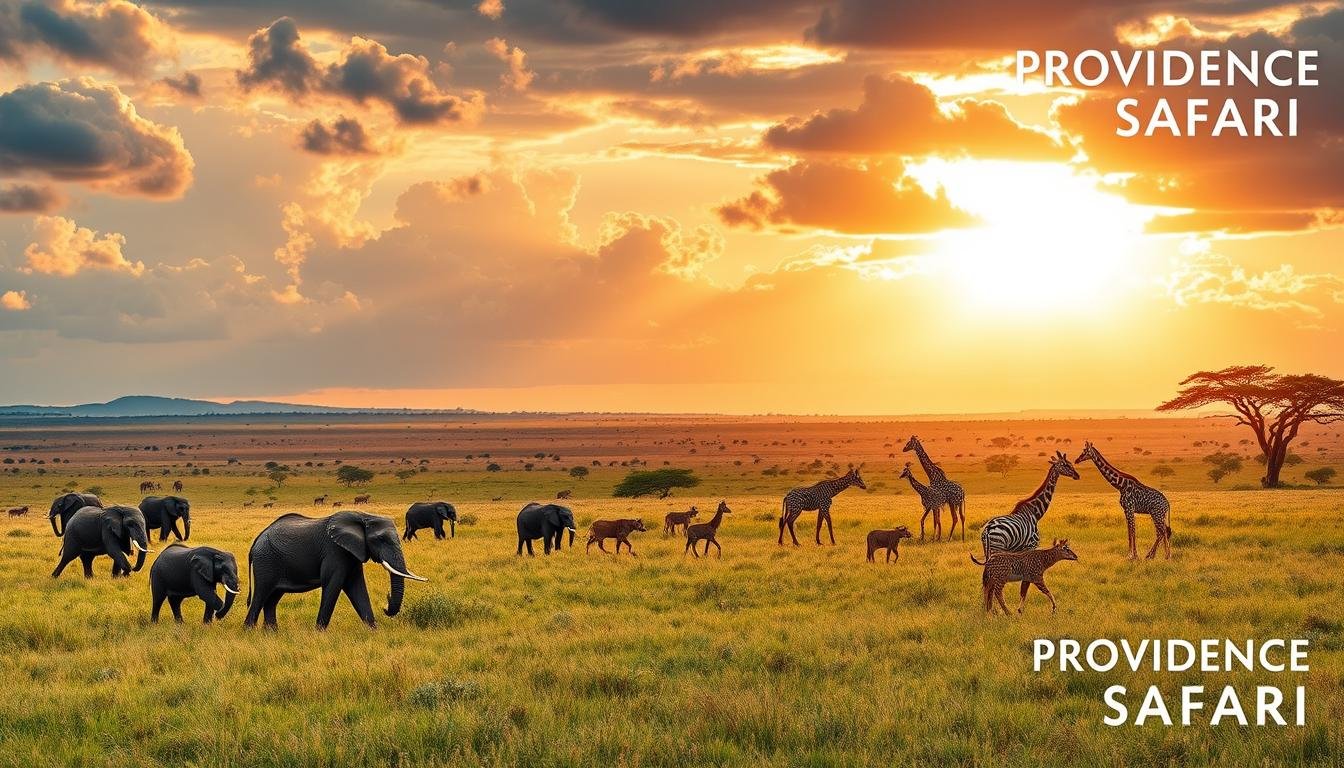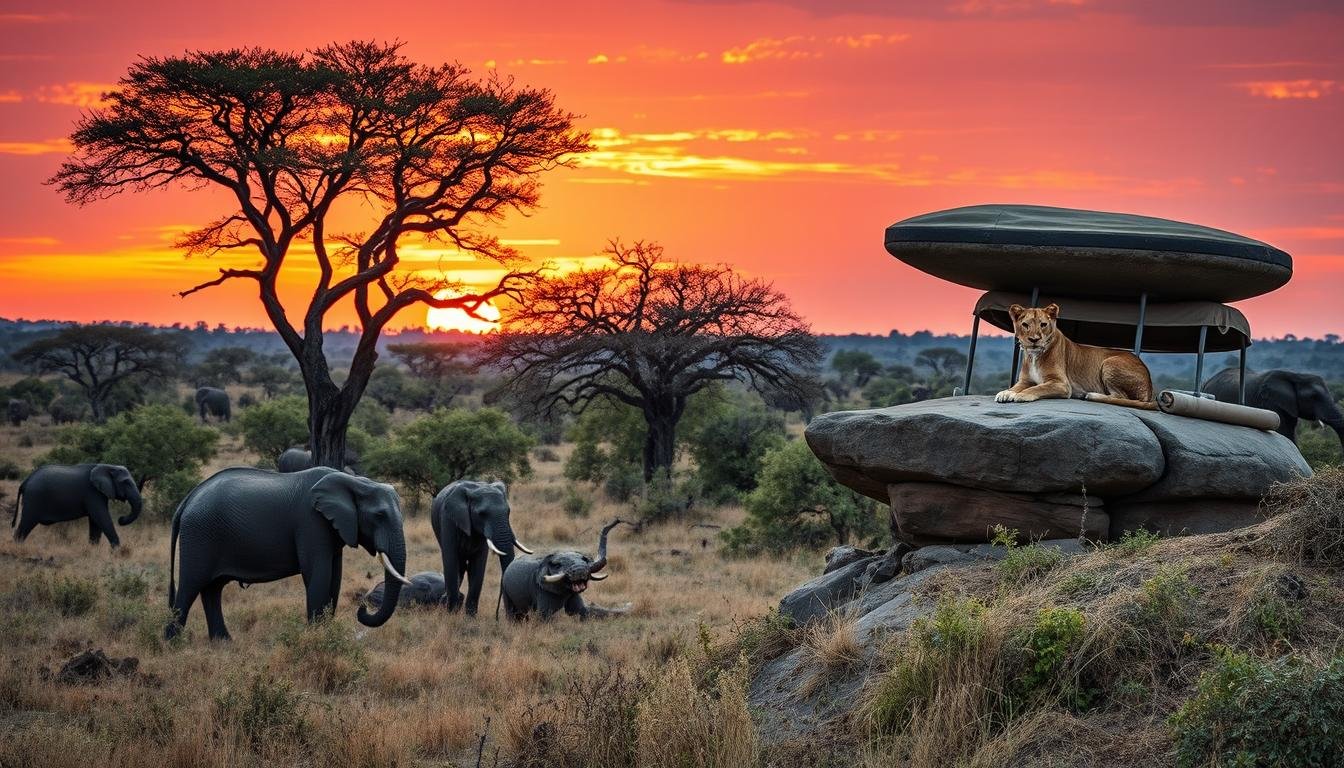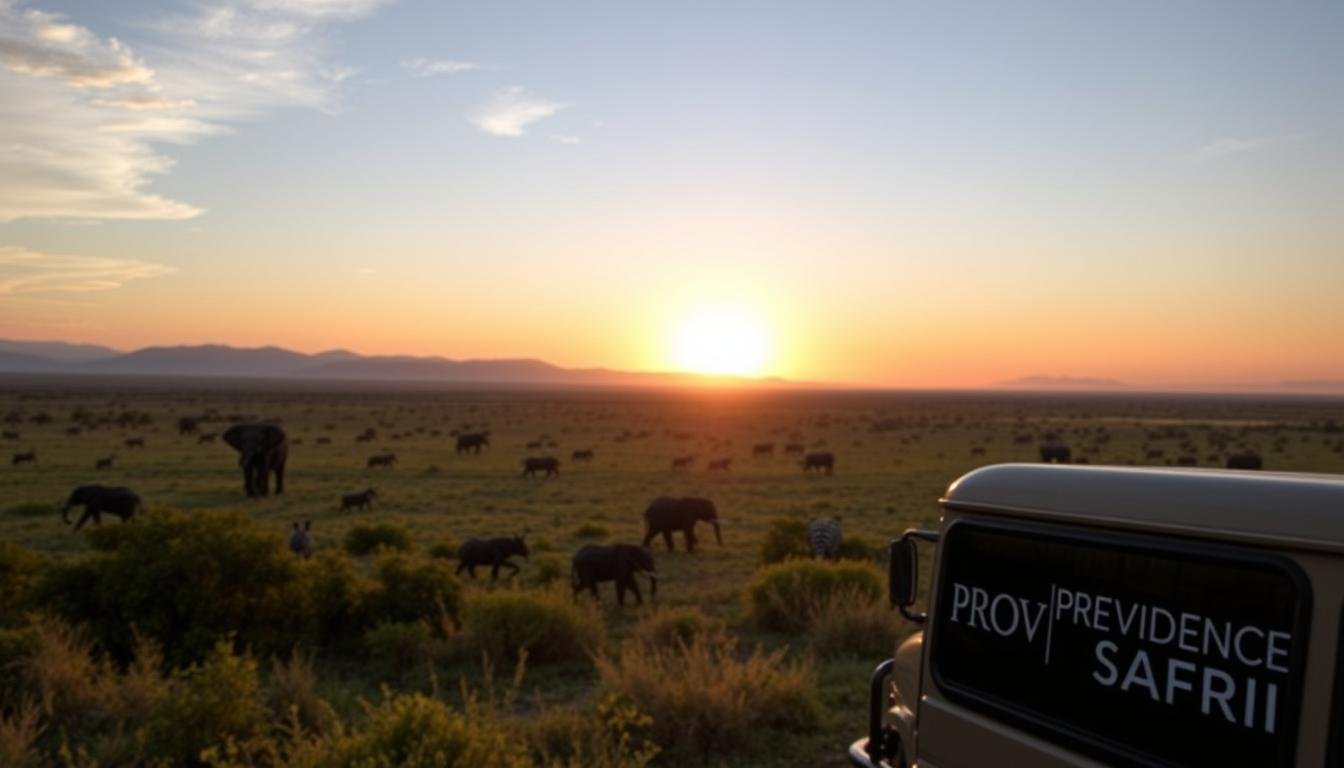Serengeti national park Tanzania safari: Welcome to Serengeti National Park, a famous wildlife spot in Tanzania. We’re about to start an exciting safari journey. We’ll see amazing landscapes, different ecosystems, and incredible animals and plants. This place is known for its beauty and will make us feel amazed.
The Serengeti covers over 12,000 square miles. It’s a huge, wild area that many people dream of visiting. Here, you can see lots of wildebeest and zebras. And also, lions and leopards in their natural habitats. Every moment here is a treat for your senses.
Key Takeaways
- Serengeti National Park is a renowned wildlife haven in Tanzania, offering exceptional safari experiences.
- Spanning over 12,000 square miles, the Serengeti is home to diverse ecosystems and abundant wildlife.
- Visitors can witness the awe-inspiring Great Migration and encounter a vast array of iconic African species.
- Serengeti safaris provide opportunities to immerse in the captivating landscapes and explore the park’s rich biodiversity.
- Careful planning and selecting the right safari operator are crucial for an unforgettable Serengeti adventure.
Introduction to Our Serengeti Adventure
The Serengeti National Park is in the heart of Tanzania. It’s a place that calls to those who love wildlife and nature. With its wide savannas, different ecosystems, and many animals, it offers a unique safari experience.
Our Serengeti safari adventure lets us see the park’s beautiful landscapes. We’ll see the amazing wildebeest and zebra migrations. And we’ll spot the hidden predators in the grasslands.
Our journey is about connecting with the wildlife and the people of the Serengeti. We’ll follow expert guides and explore the park’s secrets. This will help us understand and appreciate this fragile ecosystem.
“The Serengeti is a place that gets into your soul. It’s a land of beauty, grace, and the ultimate in natural drama.” – Dereck Joubert, National Geographic Explorer-in-Residence
As we look into our Serengeti safari packages, we’ll see many different habitats. These support a wide range of wildlife, from the Big Five to rare species. Join us for an unforgettable trip through this incredible natural wonder.
| Wildlife Encounters | Ecosystems to Explore |
|---|---|
|
|
Why Choose Serengeti National Park for Our Safari
The Serengeti National Park in Tanzania is a top choice for our safari. It’s known for its amazing wildlife viewing and diverse ecosystems. These features make it a famous safari spot.
Unique Wildlife Encounters Await Us
The Serengeti is famous for its big five game drives. Here, we can see many lions, leopards, rhinos, elephants, and buffaloes. Watching these animals in their natural home is truly awe-inspiring.
But there’s more than just the big five. The Serengeti also has cheetahs, hyenas, zebras, wildebeests, and many bird species. Seeing the Great Migration of wildebeests and zebras is an experience we can’t miss.
Diverse Ecosystems to Explore
The Serengeti is vast and varied, with different ecosystems to explore. We’ll see grasslands, savannas, forests, and rock formations. Each place is full of unique plants and animals.
Exploring the Serengeti lets us see the beauty of nature up close. We’ll learn about the balance of this ecosystem. The variety of landscapes and wildlife make the Serengeti perfect for our safari.
The Serengeti offers unmatched wildlife viewing and diverse ecosystems. It’s the best choice for our safari. We’re excited for unforgettable moments with the Serengeti’s amazing creatures and to see its natural wonders.
Best Time to Experience the Serengeti
Timing is key for a perfect Tanzania safari tours. The Serengeti National Park is full of wildlife and wonders. But, the best time to visit changes with the wildebeest migration and weather.
Seasonal Migration of the Wildebeest
The wildebeest migration is a stunning sight in the Serengeti. Millions of wildebeest move with the rains and food. The best time to see this is from July to October, when they cross the Mara River.
Weather Patterns and Their Impact
The Serengeti has two rainy seasons: “short rains” from November to December and “long rains” from March to May. These rains affect your safari. The dry season, from June to October, is best for seeing wildlife. But, the wet season offers lush greenery and newborn animals.
| Season | Weather | Wildlife Viewing |
|---|---|---|
| Dry Season (June – October) | Dry and sunny | Excellent, with more concentrated wildlife |
| Wet Season (November – May) | Rainy, with lush vegetation | Good, with the potential to see newborn animals |
The best time to see the Serengeti depends on what you want to see. Knowing the seasons and their effects on wildlife helps plan your Tanzania safari tours. This way, you can see the park’s most amazing sights.
Planning Our Safari Itinerary
Starting a Serengeti National Park safari in Tanzania is a chance to dive into one of the world’s top wildlife spots. We need to think about the different safari experiences and how long we should stay. This will help us enjoy every moment of this amazing journey.
Types of Safari Experiences Available
The Serengeti has many safari options to fit our interests. Some favorites include:
- Guided game drives: Search for the Big Five and other iconic animals across the Serengeti plains with expert guides.
- Hot air balloon safaris: See the Serengeti’s stunning views and watch the migration from above.
- Walking safaris: Go on guided walks to see the Serengeti’s varied ecosystems up close and learn about nature’s balance.
- Cultural encounters: Meet the Maasai people and learn about their traditions and customs.
Suggested Duration for Our Visit
For a Tanzania wildlife safari in the Serengeti, 5-10 days is usually best. This time lets us fully explore the park, see the Great Migration, and spot many animals and natural wonders. If we can stay longer, we’ll learn even more about the Serengeti’s amazing ecosystem.
| Safari Duration | Recommended Experiences |
|---|---|
| 5-7 days |
|
| 8-10 days |
|
By thinking about the safari options and how long to stay, we can make a perfect plan. This will help us truly experience the Serengeti National Park and make unforgettable memories of our Tanzania trip.
Essential Packing List for the Serengeti
Going on a safari in the Serengeti National Park in Tanzania needs careful planning. Whether you’re on a serengeti safari packages or a tanzania safari tours, the right clothes and gear are key. They ensure a comfortable and unforgettable trip.
Clothing Guidelines for Safari
For a safari, focus on comfort and practicality. Choose lightweight, breathable fabrics that handle the weather and dust. Here are some clothing tips:
- Long-sleeved shirts and pants in neutral colors (e.g., beige, khaki, olive) to protect against the sun and insects
- Comfortable, closed-toe shoes or boots with good traction for traversing uneven terrain
- A wide-brimmed hat or cap to shield your face and neck from the sun
- A light, packable rain jacket or poncho in case of unexpected showers
- Layers, such as a lightweight sweater or jacket, for cooler mornings and evenings
Gear and Accessories We Should Consider
There are key items to pack for your Serengeti safari:
- Binoculars for wildlife viewing
- A high-quality camera and extra batteries or chargers
- Sun protection, such as sunscreen, sunglasses, and lip balm
- Insect repellent to ward off mosquitoes and other pests
- Reusable water bottle to stay hydrated throughout the day
- A compact, lightweight daypack to carry your essentials
- Any necessary medications and a small first-aid kit
Packing the right clothes, gear, and accessories prepares you for the Serengeti’s wonders. You’ll enjoy your tanzania safari tours or serengeti safari packages fully.
Choosing Our Safari Operator
Planning our safari in the Serengeti National Park Tanzania is exciting. But choosing the right safari operator is key. This choice can greatly affect our experience, so we must be careful.
Key Factors to Consider
When looking for a safari operator, consider these factors:
- Reputation and experience: Choose a company known for safe, quality tanzania wildlife safaris.
- Ethical and sustainable practices: Make sure the operator cares about the environment and local communities.
- Variety of safari options: A good operator should offer different safari experiences to fit our preferences.
- Transparency and customer service: Good communication and quick responses are vital for a smooth planning process.
Questions to Ask Our Safari Guide
After narrowing down our choices, it’s time to talk to the safari guides. Here are important questions to ask:
- What is the average group size for your safaris, and how does this impact the experience?
- Can you provide detailed itineraries and activity schedules for the serengeti national park tanzania safari options we’re considering?
- How do you ensure the safety and comfort of your guests throughout the trip?
- Can you share feedback or testimonials from previous clients about their experiences with your company?
By carefully evaluating our options and asking the right questions, we can have a memorable and safe tanzania wildlife safaris experience in the Serengeti.
Navigating the Serengeti: Types of Safaris
As we get ready for our Serengeti safari, it’s key to know the different experiences we can have. From the excitement of game drives to the calm of walking safaris, the Serengeti is full of chances to see amazing wildlife viewing and big five game drives. These make this place truly special.
Game Drives: What to Expect
Game drives are at the heart of the Serengeti safari. They let us see the park’s wildlife up close. In special safari vehicles, we’ll look for the big five (lions, leopards, rhinoceros, elephants, and buffalos) and many other animals. Our guides will tell us about the animals’ lives and where they live, making every sighting special.
Walking Safaris: A Closer Look at Nature
- Walking safaris give us a closer look at the Serengeti’s nature.
- With skilled guides, we can explore the park’s different areas on foot. We’ll dive into the sights, sounds, and smells of the wild.
- These safaris let us see the small details of the Serengeti’s wildlife viewing. We can notice the patterns of a beetle or the balance of a fragile ecosystem.
Whether we pick the excitement of game drives or the calm of walking safaris, the Serengeti will amaze us. It promises to show us its raw beauty and the incredible moments we’ll find.
Accommodations: Where to Stay in the Serengeti
Planning our safari in the Serengeti means deciding where to stay. The park offers many choices, from luxury lodges to camping. We’ll look at the good and bad of each to pick the best for our trip.
Luxury Lodges vs. Camping Options
The Serengeti has many luxury safari lodges for a top-notch stay. These places offer comfort, beautiful views, and great service. They let us enjoy the wild while having resort-like amenities.
Camping in the Serengeti is a different, more adventurous way to experience nature. It lets us get close to the environment in a real way.
| Luxury Lodges | Camping |
|---|---|
|
|
Both luxury lodges and camping have their own benefits. The right choice depends on what we want and can afford. By thinking about what we value, we can make sure our Serengeti trip is just right for us.
“The Serengeti is a place that humbles us, inspires us, and reminds us of the beauty and fragility of our world. Choosing the right accommodation can enhance our appreciation of this extraordinary ecosystem.” – Jane Goodall, renowned primatologist and conservationist
Safety Tips for Our Safari Experience
Going on a tanzania safari tours in the Serengeti National Park is thrilling. But, we must always put safety first. Knowing how to stay safe and healthy will make our Serengeti adventure both safe and fun.
Wildlife Safety Reminders
- Keep a safe distance from all animals, even if they seem friendly. Never get too close.
- Don’t make sudden moves or loud noises. This can scare the animals.
- Listen to our experienced safari guide. They know how to keep us safe in the Serengeti.
- Never get out of the vehicle during a game drive. It’s not safe.
- Keep food and scented items away. They can attract animals.
Health Precautions and Vaccinations
To stay healthy during our Serengeti safari, we need to follow some health tips:
- Check with a doctor to see if you need any special vaccinations for Tanzania. This includes yellow fever and hepatitis A and B.
- Bring a first-aid kit with you. It should have medicines, insect repellent, and sunscreen.
- Drink plenty of water and keep clean. This helps prevent getting sick.
- Know about health risks like malaria. Use antimalarial medication if needed.
By focusing on safety and health, we can enjoy the Serengeti National Park fully. We’ll make memories that will last a lifetime on our tanzania safari tours.
| Safety Tip | Importance |
|---|---|
| Maintain safe distance from animals | Prevents unexpected encounters and ensures the well-being of both visitors and wildlife |
| Follow safari guide’s instructions | Experienced guides have extensive knowledge of the Serengeti ecosystem and can provide valuable guidance on safe practices |
| Stay hydrated and practice good hygiene | Helps maintain overall health and reduces the risk of illness during the tanzania safari tours |
| Get recommended vaccinations | Protects against potential diseases and ensures a safer, healthier safari experience |
“The Serengeti is a place that seeps into your soul. It’s not just a landscape – it’s a living, breathing entity that demands our respect and care.”
Cultural Experiences in the Serengeti
Our Tanzania wildlife safaris offer a chance to dive into the Serengeti’s rich culture. We’ll see amazing wildlife and learn about Maasai traditions. This makes our safari even more special.
Engaging with Local Communities
Meeting the local communities is a highlight of our Serengeti trip. We’ll visit villages and join in daily activities. It’s a chance to see traditional crafts and learn about the area’s history.
Learning about Maasai Traditions
The Maasai people have a long history and culture. We’ll learn about their beadwork, clothing, and connection to nature. By talking to elders and watching ceremonies, we’ll understand the Serengeti’s culture better.
These experiences make our tanzania wildlife safaris richer. We’ll appreciate the people and their way of life more. Exploring the Serengeti will leave us with a deep connection to its culture.
Photography Tips for Capturing the Serengeti
Discover the Serengeti National Park’s beauty with our photography tips. Whether you’re an experienced photographer or just starting, these tips will help you capture amazing memories from your safari.
Best Times for Wildlife Photography
The Serengeti is a dream for photographers, with its diverse wildlife and stunning landscapes. To get the best shots, consider these times:
- Early morning: Animals are most active as the sun rises, offering great chances to capture their behaviors.
- Late afternoon: As it cools down, animals become more active, showing their natural behaviors.
- During the wildebeest migration: The migration of over a million wildebeest and zebras is a must-see for photographers.
Equipment Suggestions for Our Safari
Choosing the right camera gear is key to better Serengeti photos. Here are some recommendations:
- DSLR or mirrorless camera with interchangeable lenses
- Telephoto lens (70-200mm or 100-400mm) for wildlife shots from afar
- Wide-angle lens (16-35mm) for beautiful landscapes
- Sturdy tripod or monopod for stable shots
- Extra batteries and memory cards for non-stop shooting
- Protective gear, like a camera rain cover, to keep your equipment safe
The Serengeti is a dynamic and inspiring place. With the right tips and gear, you’ll capture its essence and make unforgettable wildlife viewing memories.
Understanding the Ecosystem of the Serengeti
As we start our tanzania wildlife safaris in the Serengeti National Park, we must appreciate the complex ecosystem. This region is home to diverse flora and fauna and ongoing conservation efforts. Exploring the Serengeti’s natural wonders will make our safari experience richer.
Flora and Fauna We Might Encounter
The Serengeti has vast, open grasslands and diverse habitats. We might see iconic wildebeest and zebra, and predators like lions, leopards, and cheetahs. The park is also a haven for bird species, from the majestic secretary bird to the vibrant lilac-breasted roller.
Conservation Efforts in the Park
Keeping the Serengeti’s ecosystem balanced is crucial. We’ll learn about the park’s conservation efforts. These include monitoring wildlife and protecting endangered species. The work of researchers and park rangers ensures the Serengeti’s future.
“The Serengeti is a place that gets in your soul. It’s a vast, wild, untamed landscape that captivates the senses and inspires a sense of wonder and reverence.” – Jane Goodall
Our Serengeti National Park tanzania safari will deepen our appreciation for life’s web in this ecosystem. By exploring and learning about conservation, we connect with nature and become its guardians.
Responsible Safari Practices We Should Follow
When we go on a Serengeti safari, it’s key to follow responsible tourism. This helps the local economy and keeps our environmental impact low. By being careful with our actions, we make sure our safari is good for everyone.
Supporting Local Economies
Being a responsible tourist means supporting local economies. When we book our safari, choose operators that hire local guides and buy from local suppliers. This helps the community and gives us a real cultural experience.
- Look for safari operators that work with local communities.
- Buy souvenirs and crafts from local artists and vendors.
- Eat at local restaurants and support small businesses.
Minimizing Our Environmental Impact
It’s vital to protect the Serengeti for future visitors. As travelers, we can reduce our environmental impact on safari.
- Follow park rules and listen to our guide to not disturb wildlife.
- Dispose of waste properly and don’t litter, even in remote spots.
- Use water and energy wisely in our lodgings.
- Think about carbon offset programs to lessen our travel’s impact.
By following these responsible safari practices, we ensure our Serengeti safari is good for the community and the environment. Together, we help preserve this amazing place for the future.
Post-Safari Reflections: What We Learned
Our Serengeti National Park safari in Tanzania has ended, but we’re filled with awe. We now appreciate wildlife viewing and conservation efforts more than ever. The memories we made will inspire us to keep exploring and caring for nature.
Memorable Experiences to Cherish
Seeing the wildebeest migration and meeting lions, leopards, and elephants was incredible. Our adventure in the Serengeti has changed us. We’ve learned about the vast wildlife and the beauty of nature.
“The Serengeti taught me the meaning of tranquility and the beauty of solitude.” – Sylvia Earle
Continuing Our Conservation Efforts
Leaving the Serengeti, we’re more determined to help protect it. We understand the challenges and the work of local communities and organizations. We promise to support sustainable tourism, eco-friendly projects, and share our stories to inspire others.
Our safari in the Serengeti has sparked a deep passion for nature. As we head home, we’re filled with purpose and a love for the natural world’s beauty and strength.
Conclusion: Planning Our Dream Safari Adventure
Reflecting on our journey through the Serengeti National Park, we see the wealth of experiences waiting for us. The awe-inspiring wildlife and diverse ecosystems make this place a top choice for safari lovers.
Our adventure could include watching the wildebeest migration or searching for the Big Five. We can also learn about the Maasai people’s culture. By planning well, packing right, and choosing a good safari operator, our trip will be unforgettable and responsible.
Starting this journey, we get to connect with nature and support conservation. We’ll make memories that will inspire us to go on more serengeti national park tours and tanzania wildlife safaris. The Serengeti’s beauty and wildlife invite us to explore and cherish its wonders.




